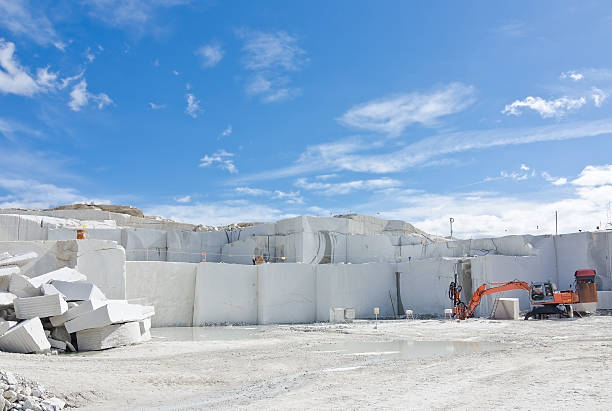Introducing Granite Quarries in South Africa Tradition: A Trip Through Quarries
Introducing Granite Quarries in South Africa Tradition: A Trip Through Quarries
Blog Article
Unearthing the Rich Background and Lasting Practices of Granite Quarrying
As we base on the precipice of revealing the detailed tapestry of granite quarrying, a trip via time reveals not just the physical act of removing rock but additionally the cultural and historic significance woven right into the very fabric of this technique. From the old beginnings that laid the structure for modern quarrying methods to the lasting practices that are shaping the future of this market, each carve mark on granite surfaces informs a tale waiting to be unearthed (granite quarries in south africa). The tradition of granite quarrying extends far past plain removal; it is a testimony to human resourcefulness, durability, and the enduring attraction of this majestic stone
Old Beginnings of Granite Quarrying
Going back to old human beings, the method of quarrying granite has actually been an integral part of human history and architectural development. The earliest evidence of granite quarrying go back to old Egypt, where large pyramids and detailed sculptures were crafted from this sturdy stone. The Egyptians utilized primitive devices to draw out granite blocks from quarries, showcasing the relevance of this material in their huge constructions.
Progressing in background, the Greeks also made significant payments to the quarrying of granite. The Greeks utilized granite in various architectural wonders, such as temples and statues, showing their skill in shaping and carving this sturdy stone. The Romans further fine-tuned the techniques of quarrying granite, utilizing advanced devices like knives and hammers to essence and shape granite for their renowned frameworks.
With the centuries, the technique of quarrying granite has advanced, with modern-day innovations boosting efficiency while keeping the ageless charm of this all-natural stone - granite quarries in south africa. From ancient worlds to contemporary home builders, the legacy of granite quarrying proceeds to shape our globe
Advancement of Quarrying Strategies
The development of quarrying techniques has actually been noted by a continual progression in the direction of higher performance and precision in extracting granite. Early quarrying strategies included manual labor with fundamental devices such as chisels, hammers, and wedges to draw out granite blocks from the planet.
In even more current times, the introduction of machinery changed the quarrying market, allowing quicker removal prices and enhanced efficiency. Technologies such as diamond cable saws, high-pressure water jets, and pneumatic drills have ended up being standard in modern-day quarries, enabling accurate cutting and decreased waste. Furthermore, innovations in computer-controlled devices and 3D modeling have maximized quarrying operations, resulting in minimal ecological impact and boosted sustainability techniques. As the need for granite proceeds to climb, the development of quarrying techniques continues to be indispensable to conference sector requires efficiently and sustainably.
Social Relevance of Granite
Granite holds an extensive social relevance across various civilizations due to its long-lasting visibility in building masterpieces and admired monuments. From the majestic pyramids of Egypt to the intricate makings of the Angkor Wat holy place in Cambodia, granite has been a material of choice for sharing magnificence and durability in cultural heritage. In ancient Rome, granite columns adorned holy places and public buildings, symbolizing toughness and durability. The cultural significance of granite expands past its physical characteristics; it embodies resilience, stability, and eternity, making it an icon of withstanding legacies and traditions.

Sustainable Practices in Quarrying
Amidst the abundant background of granite quarrying and its cultural significance exists a growing emphasis on lasting methods within the industry. As ecological understanding and issues about resource deficiency have actually increased internationally, the quarrying industry has increasingly welcomed lasting techniques to reduce its effect on the atmosphere and surrounding communities.

Moreover, improvement and rehabilitation of quarry websites post-extraction are essential to lasting methods. By recovering quarried locations to an all-natural or beneficial state, such as creating wild animals environments or leisure areas, quarriers can balance out the environmental footprint of their operations and contribute favorably to the neighborhood ecosystem.
Legacy of Granite Quarrying
With a historic background soaked in craftsmanship and industrial development, what withstanding impact has granite quarrying left on the landscape of modern society? The legacy of granite quarrying transcends plain extraction practices; it has actually formed building wonders, city landscapes, and cultural heritage worldwide. The durable nature of granite has actually made it a preferred selection for monuments, structures, and framework, standing as a testimony to the ability and virtuosity of quarry employees throughout generations.
Moreover, the economic footprint of granite quarrying can not be forgotten. The sector continues to give employment possibility and drive regional economic climates in regions where granite removal prevails. It has also stimulated technological advancements in quarrying strategies and devices, leading to extra effective and sustainable techniques.
In terms of sustainability, the legacy of granite quarrying consists of initiatives to reduce environmental influences through reclamation projects and accountable source management. By try this out stabilizing economic passions with environmental stewardship, the sector makes every effort to guarantee that future generations can continue to take advantage of this long-lasting natural deposit.
Conclusion

Report this page